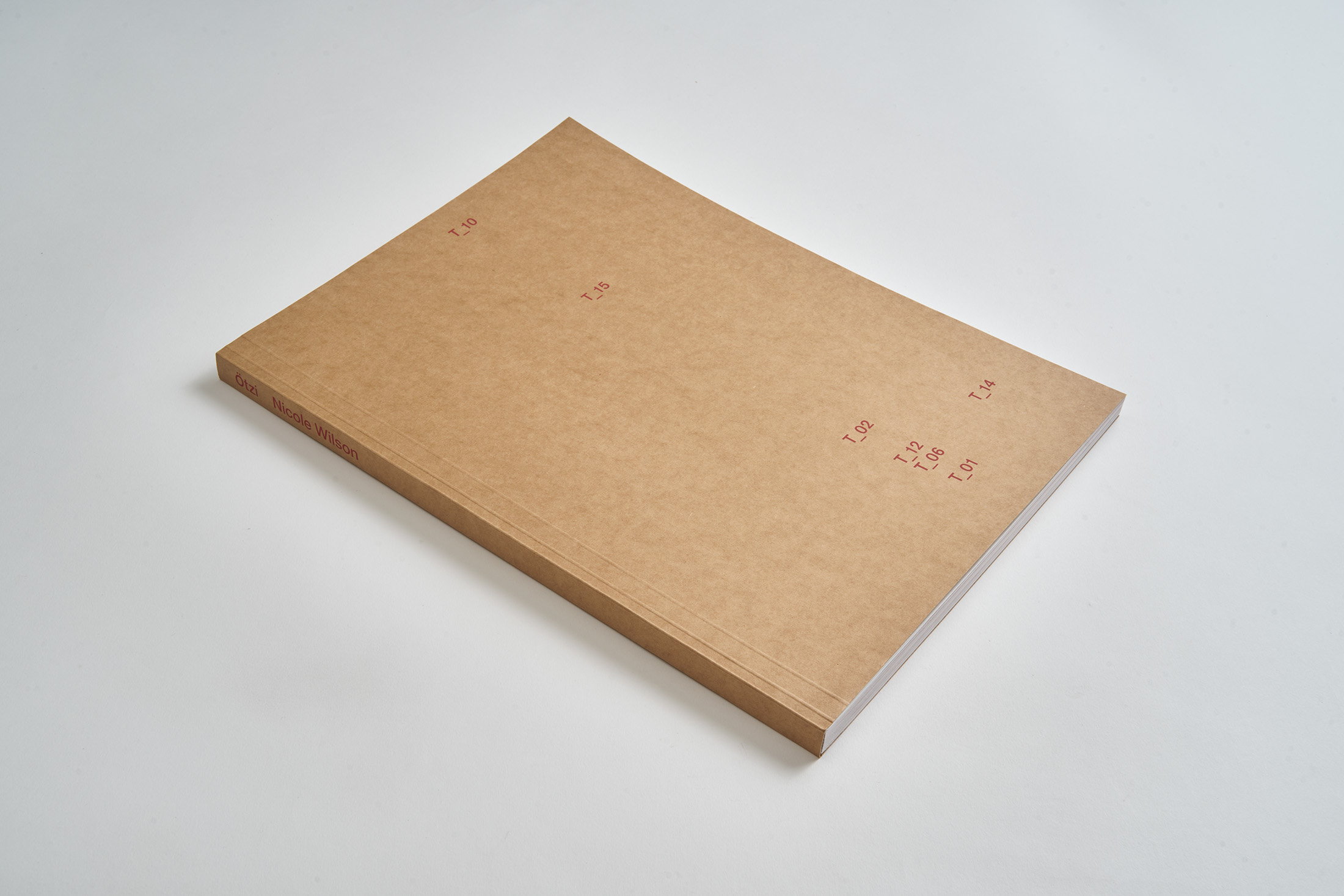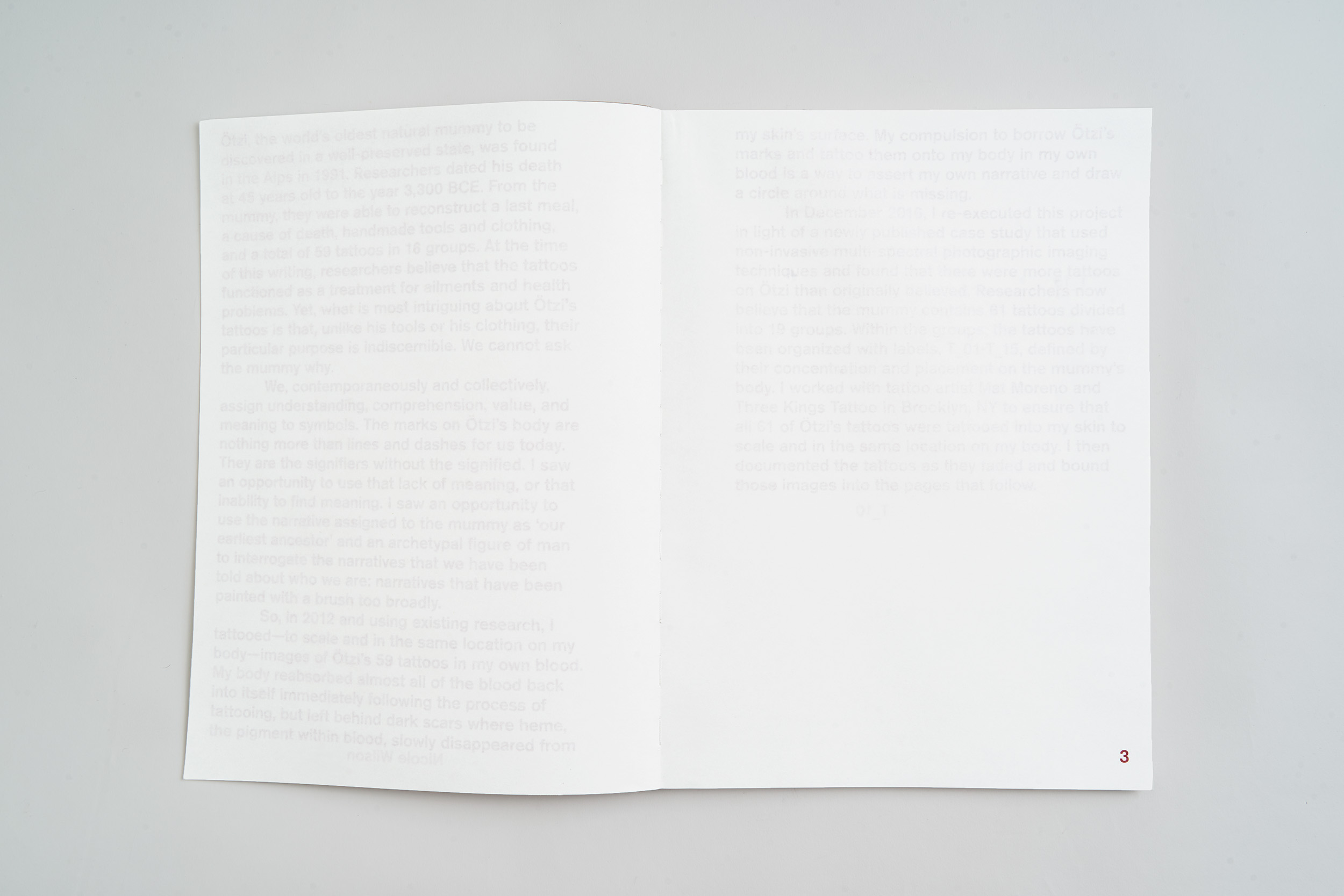



ÖTZI$60
Nicole Wilson
2021
In the 1990s, a body was discovered in the Alps on the border of Austria and Italy. This glacier mummy is now known as Ötzi, a Copper Age male (scientists date him to 3300 BCE) whose body is preserved, cared for, and researched at the South Tyrol Museum of Archaeology in Italy. According to the museum, “61 tattoos were found on Ötzi’s body, all in the form of lines or crosses. Unlike modern tattoos, they were not made with a needle; they were fine incisions into which pulverised charcoal was rubbed. The tattoos are located near his ribcage and lumbar spine, on his wrist, knee, calves and ankles.” Ötzi is considered the oldest tattooed human mummy yet discovered (in 2018, nearly contemporaneous tattooed mummies were discovered in Egypt).
A world away in the United States, the artist Nicole Wilson learned about Ötzi, Europe's oldest known natural human mummy. An artist who has focused on sculpture and durational, process-driven works, Wilson created this work because “Ötzi stands in for an archetype, his marks are the signifiers without the signified. In that way, I saw an opportunity to use that lack of meaning (or our inability to to find meaning) as a way to go further of what this mummy means to us contemporaneously and access him as an archetypal figure of ‘man’.”
In 2012, using the most current research available on Ötzi, Wilson tattooed images of the mummy’s 59 known tattoos on her body using her own blood. Her body reabsorbed almost all of the blood back into itself immediately following the tattooing, but left behind dark scars where heme, the pigment within blood, slowly disappeared from the skin’s surface.
In 2016, Wilson decided to re-execute this project following a new study that discovered more tattoos on Ötzi. Researchers used non-invasive multi-spectral photographic imaging techniques and found that there were more tattoos on Ötzi than originally believed. The research confirmed that the corpse contains 61 total tattoos divided into 19 groups.
In December 2016, Wilson brought two vials of her own blood to Three Kings Tattoo in Brooklyn. From the existing research, she had already rendered Ötzi's tattoos concisely into digital design files that were then used to make stencils on site. The tattoo artist Mat Moreno tattooed the designs on her skin, using her blood as the pigment. Once again, her tattoos and placement matched Ötzi's.
Over the next four years, Wilson documented the tattoos as they faded. Photographs of this fading process are documented in this artists book where nearly life-sized images of Wilson’s skin are printed in chronological order on toothy, pliant pages.
Read more about the book and artist here.
This title is held in the collections of:
The Metropolitan Museum of Art
The School of the Museum of Fine Arts at Tufts University
University of Arkansas
Production Details
9.8 × 13.5 in
96 pages
Softcover
Quater-fold, smyth-sewn Otabind
Cover material: Kraftliner 275gsm, 1/0 PMS
Paper inner: 70gsm Munken Print white
5 color offset printed (2 color +2PMS/1PMS)
Colophon
Edition of 500
Published by Small Editions
Designed by Bryant Wells
Nicole Wilson
2021
In the 1990s, a body was discovered in the Alps on the border of Austria and Italy. This glacier mummy is now known as Ötzi, a Copper Age male (scientists date him to 3300 BCE) whose body is preserved, cared for, and researched at the South Tyrol Museum of Archaeology in Italy. According to the museum, “61 tattoos were found on Ötzi’s body, all in the form of lines or crosses. Unlike modern tattoos, they were not made with a needle; they were fine incisions into which pulverised charcoal was rubbed. The tattoos are located near his ribcage and lumbar spine, on his wrist, knee, calves and ankles.” Ötzi is considered the oldest tattooed human mummy yet discovered (in 2018, nearly contemporaneous tattooed mummies were discovered in Egypt).
A world away in the United States, the artist Nicole Wilson learned about Ötzi, Europe's oldest known natural human mummy. An artist who has focused on sculpture and durational, process-driven works, Wilson created this work because “Ötzi stands in for an archetype, his marks are the signifiers without the signified. In that way, I saw an opportunity to use that lack of meaning (or our inability to to find meaning) as a way to go further of what this mummy means to us contemporaneously and access him as an archetypal figure of ‘man’.”
In 2012, using the most current research available on Ötzi, Wilson tattooed images of the mummy’s 59 known tattoos on her body using her own blood. Her body reabsorbed almost all of the blood back into itself immediately following the tattooing, but left behind dark scars where heme, the pigment within blood, slowly disappeared from the skin’s surface.
In 2016, Wilson decided to re-execute this project following a new study that discovered more tattoos on Ötzi. Researchers used non-invasive multi-spectral photographic imaging techniques and found that there were more tattoos on Ötzi than originally believed. The research confirmed that the corpse contains 61 total tattoos divided into 19 groups.
In December 2016, Wilson brought two vials of her own blood to Three Kings Tattoo in Brooklyn. From the existing research, she had already rendered Ötzi's tattoos concisely into digital design files that were then used to make stencils on site. The tattoo artist Mat Moreno tattooed the designs on her skin, using her blood as the pigment. Once again, her tattoos and placement matched Ötzi's.
Over the next four years, Wilson documented the tattoos as they faded. Photographs of this fading process are documented in this artists book where nearly life-sized images of Wilson’s skin are printed in chronological order on toothy, pliant pages.
Read more about the book and artist here.
This title is held in the collections of:
The Metropolitan Museum of Art
The School of the Museum of Fine Arts at Tufts University
University of Arkansas
Production Details
9.8 × 13.5 in
96 pages
Softcover
Quater-fold, smyth-sewn Otabind
Cover material: Kraftliner 275gsm, 1/0 PMS
Paper inner: 70gsm Munken Print white
5 color offset printed (2 color +2PMS/1PMS)
Colophon
Edition of 500
Published by Small Editions
Designed by Bryant Wells
REQUEST A QUOTE
SCHEDULE A CONSULTATION
Lorem Ipsum
